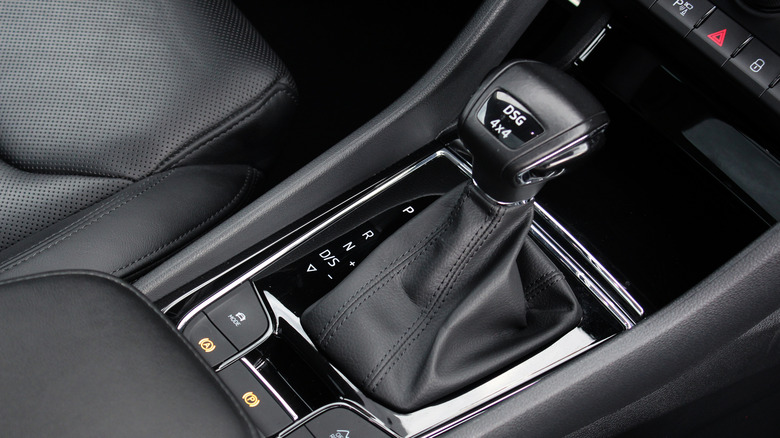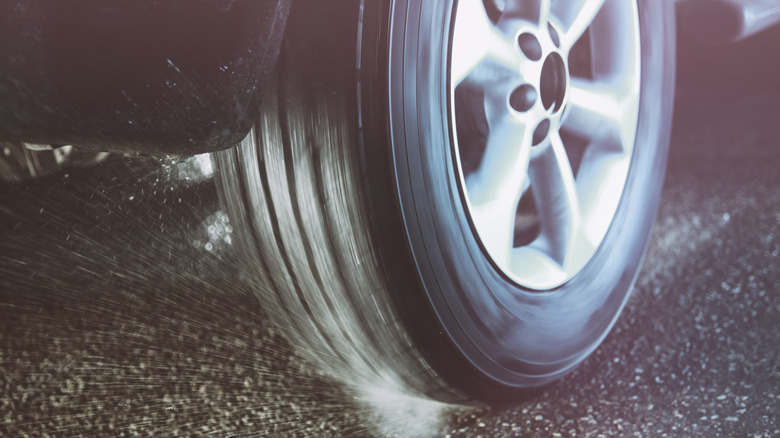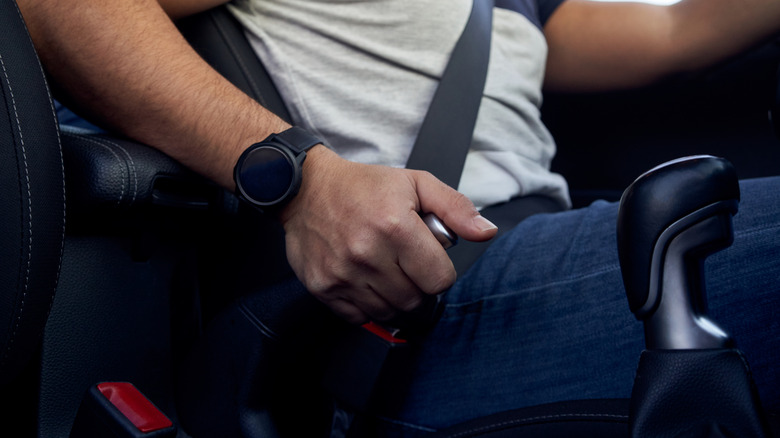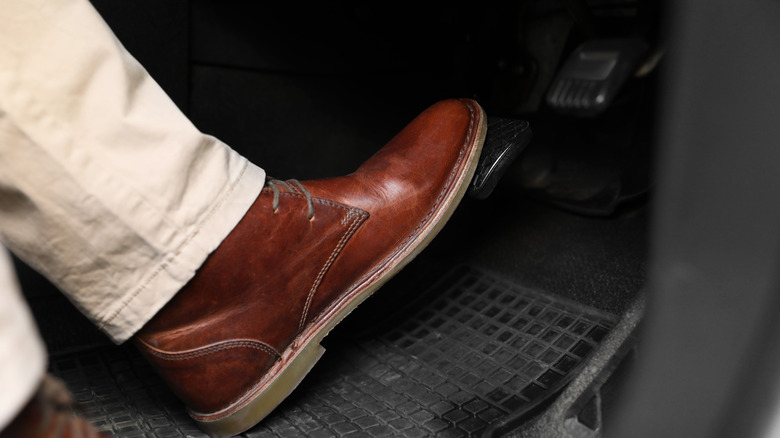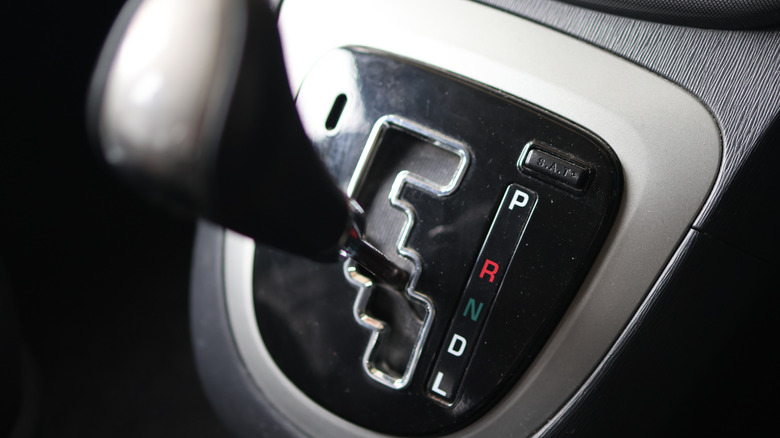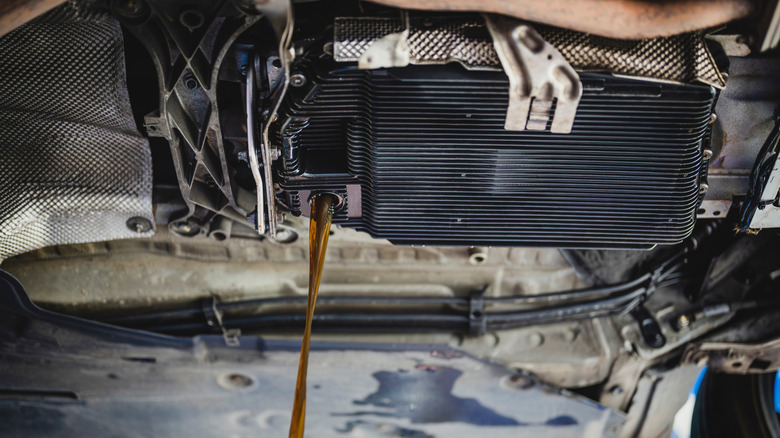5 Mistakes You Need To Stop Making If Your Car Has An Automatic Transmission
If you get into a brand-new car, chances are it's going to have an automatic, especially since more manual transmission cars are being discontinued. These days, less than 1% of new cars sold come with manual transmissions, with the vast majority either being traditional automatics, CVTs, and DCTs, in that order. Yet, despite their prevalence and ease of use, there remain some common quirks and idiosyncrasies common to all automatic transmissions, along with various minor handling errors that can range from anything to gently overheating your car's working components, right up to potentially blowing out your transmission.
The vast majority of what we'll talk about are the former — minor mistakes that almost anyone's guilty of doing at least a few times if they've been driving a while. It's when you repeat these mistakes or follow these poor driving habits time and again that you start to see some real damage accruing. We've already taken a look at some of the things you need to stop if you have a car with an automatic transmission, but the complete list extends well beyond this, so let's take a look at a few more.
As a disclaimer, every car's transmission is slightly different. Therefore, this list only applies to your typical automatic with a torque converter as you'd find in many current and former production cars; it does not apply to other automatic transmissions like CVTs or EV direct-drive. This list also covers mainly more obscure points relating to the function of an automatic, as opposed to common-sense dos and don'ts. So without further delay, let's get into it.
Using the neutral gear to launch the car
Commonly referred to as "neutral-dropping," this involves shifting to neutral at a standstill, revving up the engine, then shifting into drive to achieve a hard launch, like dumping the clutch in a manual. It used to be more prevalent in the '60s and '70s, prior to specialized torque converters that held higher engine idle speeds. And if done improperly, it will brutalize your transmission from torque stress.
In order to more precisely understand why it's so bad, let's discuss how a torque converter actually works. The process is similar to mixing cake batter — a torque converter uses fluid dynamics to transfer force from the engine to the transmission. To put it in a simplified format, a torque converter houses two turbines which are bathed in transmission fluid, with one turbine connected to the engine's output shaft. As it spins, the fluid builds up momentum, transferring that to the turbine connected to the transmission. They're more complicated, of course, but that's the basic principle, and is why automatic transmissions don't have a traditional clutch.
With that in-mind, think about the effect of revving up a cake mixer as fast as you can and suddenly dunking it into the bowl of cake batter. That's the same general effect neutral-slamming has on the transmission. The "correct" way to do it is to hold a steady RPM to build up that momentum properly, shift to drive, and then press on the gas after it hooks. In other words, don't apply torque when shifting from N to D, otherwise you'll quickly figure out which component of your transmission is weakest the hard way.
Not using the handbrake when parked
It's generally understood that the "Park" gear in an automatic is just that — only to be used when parked. But what does it do, and why even apply the handbrake at all with it engaged, since it holds a car on its own just fine? Let's take a look at how exactly the "Park" gear works.
It's basically a neutral gear that locks the transmission like a padlock. Similar to how you can't turn a lock without the key because the tumblers are in the way, you can't rotate the driveline in Park because of a device called a parking pawl. A parking pawl is an arm resembling a hammer; when you shift into Park, the arm pivots up and locks into a corresponding recess on the output shaft, physically securing it from moving. That's why, for instance, your car may slip forward or backward before you hear a "click" when you park, it's the parking pawl locating that recess and snapping into it, and is perfectly normal.
Parking pawls are quite durable, provided you don't slam the car into park while it's still moving, of course. However, let's suppose you park on a hill without the handbrake. You're now effectively resting all several thousand pounds' worth of car on that one singular component. If the pawl itself is damaged or corroded, it could fail, and then you suddenly have no more park gear, hence why the handbrake is useful as a safety device and to prolong the parking pawl's service life. After all, it's also called a "parking brake" for a reason. Just don't forget to disengage it before setting off, otherwise it can warp your brake rotors.
Left-foot braking
This doesn't actually hurt the transmission, but rather is an issue of dexterity. If you've watched a lot of motorsports, one thing you may notice in a pedal-camera is that many drivers rest their left foot on the brake pedal in a two-pedal race car. This serves a practical purpose in racing, which involves advanced braking techniques like trail-braking, for example, and is one reason why specialized vehicles like Formula One cars move their clutch pedal to a hand control. But it serves no such function in city traffic; moreover, it's actually a safety hazard, and that relates to your coordination.
Sure, it may seem like your left foot does nothing in automatics, so why not use it for braking? Well, muscle memory is incredibly important in a worst-case scenario. Imagine, for instance, that you're startled by an obstacle like a pedestrian or object suddenly appearing on the road. Your gut instinct is to slam on the brakes and take evasive action.
Now, let's say your left foot is on the brake and your right is on the throttle. What may happen, if you're not practiced with left-foot braking, is that you instinctively slam on both the brake and throttle at the same time. The car then cannot overcome the force of the hard acceleration in time, drastically extending your braking distance and melting your brakes in the process. Similarly, it can be something as innocuous as a sudden brake when reversing in a parking lot, as another example — anything involving quick braking applies here. Like learning drums for the first time, it takes practice and time to build up a new skill involving additional coordination, and left-foot braking is no exception.
Shifting to neutral while coasting downhill
We've previously covered why shifting to neutral while stopped is a bad idea, and the variation of revving it up before slamming it into drive can wreck your gearbox. But what about if you're just going down a steep road and want to save fuel by shifting to neutral, so your car goes into a low-idle? The first and most obvious point against this practice is simply that you might forget the car is in neutral after some time, and suddenly you're left without any drive. But leaving aside the common human ailment of forgetfulness, it also just relinquishes an amount of control one has over their car for little to no benefit versus alternatives that do offer more tangible rewards.
Let's say, for instance, that you want to shift to neutral because you want to help your car brake. Engine braking is actually a thing with automatics, and it doesn't involve changing to neutral. Rather, it involves locking the car into a gear, as opposed to its natural state of free-wheeling in drive. This involves downshifting the car manually using the shifter itself or paddles — for instance, shifting into "3" or "L" gear.
This forces the transmission into gear, allowing you to engine brake an automatic transmission vehicle down a hill and preserve your brake pads in the process. Moreover, this practice offers no compelling benefits. Shifting to neutral while coasting downhill doesn't actually save fuel, since the engine is still running and wouldn't use any more fuel than simply free-wheeling down the road, like a bicyclist lazily pedalling down a shallow incline.
Overfilling your transmission fluid
We've previously discussed the function of transmission fluid in the torque converter; it acts like a fluid coupling between engine and transmission. Theoretically, much like the cake batter analogy, if you were to simply pour more in, the car will perform better since there's more fluid for the turbines to catch, right? In short, no, overfilling your transmission fluid is dangerous to numerous components in the torque converter, here's why.
Imagine you pour in more cake batter into the mix. What happens when you try to mix it with the same mixer pressure? The batter moves more slowly; there's too much to all move at once. The same principle applies here; consequently, one of the early symptoms of overfilled transmissions is an overheating engine due to reduced lubrication. Moreover, the pressures generated by the excess liquid produce air pockets in the fluid itself, causing the fluid to foam and bubble. These air pockets don't compress and move in ways the designers anticipated, leading to sudden pressure and heat buildup and subsequent transmission damage.
Instead of simply pouring more transmission fluid in, you should instead replace your transmission fluid, like changing the oil. How often you should change transmission fluid depends on the car and transmission configuration. But there's a remarkable amount of potential failures and pitfalls, and subsequent hefty bills from transmission specialists, that are easily avoided by properly doing the maintenance.
